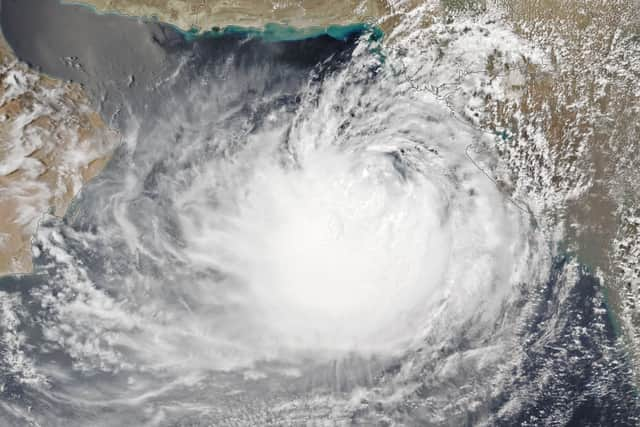Cyclone Biparjoy: storm makes landfall in India and Pakistan as 170,000 people evacuated
and live on Freeview channel 276
Cyclone Biparjoy, which means 'disaster' in Bengali, touched down on the coast of India and Pakistan on Thursday 15 June, with more than 170,000 people evacuate from their homes in the areas which were expected to be badly hit. Homes and buildings have been destroyed, with two people - a father and son - killed in the storm.
Advertisement
Hide AdAdvertisement
Hide AdPower was cut to almost 1,000 villages, with shipping containers also thrown into the sea. However, officials in India have said that the strength of the storm has been downgraded from 'very severe' to 'sever', with many hoping that the worst of the impact has passed
North-western areas of India and southern parts of Pakistan are currently being battered by gale force winds and heavy rain. Rescue services have been put on standby as authorities prepare to deal with the aftermath of the cyclone.
According to the NASA Earth Observatory, the cyclone had been brewing in the Arabian Sea for over a week before it was first expected to hit land. Unusually warmer winds in the sea, owning to increasing temperatures, have contributed to the storm's growing strength, with wind speed predicted to reach 125km/hr to 135km/hr and wind gusts of up to 150km/hr by the time it reaches land.
Biparjoy comes after the region experienced deadly floods last year, with 1,700 people killed in Pakistan as a result of the extreme weather.
Advertisement
Hide AdAdvertisement
Hide Ad

What areas of India and Pakistan are being hit by Cyclone Biparjoy?
The cyclone is predicted to primarily hit the stretch of coast between the two countries. This includes the 200 mile stretch between the coast ton of Mandvi in the Gujarat state of Indian, up to the major, and densely populated, city of Karachi in Pakistan.
The Indian Meterological Department predicts that the storm is due to hit the port village of Jakhau on Thursday (15 June) late evening. Anxiety around the impact on smaller towns and villages with poorer infrastructure along the coastline is high, with the department also warning of the "total destruction" of traditional mud huts and straw thatched homes.
The south-eastern province of Sindh in Pakistan was due to be hit by gusts of up to 140km/hr, with storm surges possibly reaching as high as 11.5ft.
After it touched land, the storm moved towards the north-eastern region of India and is said to have weakened into a cyclonic storm. The storm is expected to develop into a depression as it reaches south Rajasthan.
Advertisement
Hide AdAdvertisement
Hide AdWhat have officials said about the cyclone?
Rushikesh Patel said that preparations such as evacuations and rescue teams on standby have been taken as the county aims to "ensure zero casualties". It comes after at least seven people reportedly died during heavy rain earlier this week in India, including incidents of drownings off of the coast of Mumbai.
The World Health Organisation has also said that it was helping to aid and support government's efforts to negate the effects of the powerful storm as it touches lands. Free food and clean drinking water has been delivered to those forced to flee their homes.
Comment Guidelines
National World encourages reader discussion on our stories. User feedback, insights and back-and-forth exchanges add a rich layer of context to reporting. Please review our Community Guidelines before commenting.
